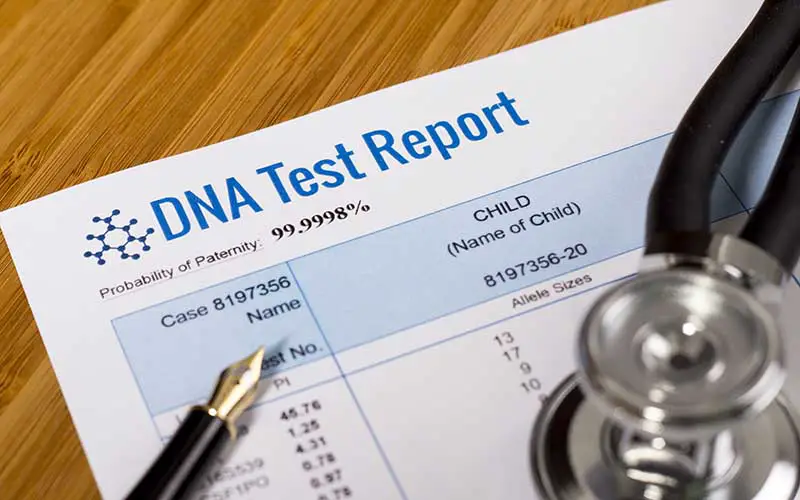Finding out your ancestral history has been quite an exciting revelation for many people around the world.
Some people verified what they had already known from their family stories.
Others found a family history that they never imagined.
But, just how accurate are the ancestral DNA test results from a Direct-to-Consumer Genetic Testing Company or DTC?
Yes, ancestral DNA can be wrong when estimating your ethnicity. It is just that – an estimate, not a guarantee.
Each company has its own database for a reference population. However, that does not mean your DNA test is inaccurate. The actual testing of the DNA has a 99.9% accuracy rate.
Are you feeling confused?
Don’t worry!
If you keep reading below, we will dive into genetics and how these ancestral DNA companies operate.
Plus, we will look at why these tests are wrong.
First, How the Ancestral DNA Craze Began
In 2003 the world changed overnight when scientists from the Human Genome Project introduced a complete human DNA sequence.
This eventually led to the technology that allowed us to read DNA in a speedy and fairly inexpensive manner.
As a result, scientists were now able to examine hundreds of thousands of people’s DNA for very little money.
This is what started the commercial interest in sequencing or reading DNA.
Immediately the DCT companies began popping up, such as:
- 23andMe
- AncestryDNA
- MyHeritage
- Dozens more
As a result, we now have millions of people who have submitted their DNA samples to these DCT companies in search of their family history.
Okay.
Now that you have spit in the tube or swabbed your cheek and sent it off for your results let’s take a look at what it all means.
What is DNA?

DNA is like the owner’s manual for your body.
It is the molecules inside cells that hold our genetic information called genomes.
Additionally, DNA is broken down into four letters, A, C, G, and T.
These might just appear to be some random letters.
But it is these letters that when lined up and spelled out within your DNA.
They give the orders that tell the cells what molecules need to be made:
- Adenine
- Cytosine
- Guanine
- Thymine
Those Nucleotides (the Letters above) appear around six billion times in one DNA cell, and how they line up within the genome is what makes up our genetic code or sequencing.
In fact, the different sequences of the letters make different proteins in the body.
The proteins are what make up the different traits.
Scientists can compare the sequences of the nucleotides to other DNA samples, and they will be different in every human being.
Except for 99.9% of your DNA.
The DNA in humans is 99.9% identical.
So one-tenth of a percent 0.01% is what makes each human being an individual.
Other than that one-tenth of one percent, we are all precisely the same.
Also, it is that 0.01% that gets evaluated during DNA testing.
The Direct-to-Consumer DNA Test?

The Ancestral DNA companies are using an SNPs (Single Nucleotide Polymorphisms) test.
This test looks at a single portion of the DNA strand.
The SNP test roughly looks at around half a million of the letter combinations and runs the test repeatedly to ensure accuracy.
That is the part of the DNA testing that is accurate 99% of the time.
The Ethnicity of Your DNA

Now that the company has run their test and isolated the 0.01% that makes you who you are as a person, you can receive your results.
Translated, this means you now become 70% this, 25% that, and 5% something else.
This was when the mistake occurs, and people are most often misled.
In fact, DNA testing cannot definitively decode a person’s race or ethnic background.
What happens is the companies digitize your DNA sample, then run it through a computer algorithm system.
The computer compares your sample with millions of other examples from different regions of the world and splits it up by where there are matches in the genetic markers.
The comparable data comes from a mix of independent research companies and people who could give factual information about their ancestors.
The Big Three Databases
Earlier, we mentioned that there are dozens of DtC databases on the market, but there are three with which most people are very familiar.
They are:
- 23andMe has around ten million comparable samples in its database, making it the second-largest of the Direct-to-Consumer genetic testing companies.
- Ancestry.com currently has the most extensive comparable sample database with 18 million.
- MyHeritage has the smallest database out of all the DTC companies. With 2.4 million comparable samples within their database.
Each company has its own database of DNA samples but runs a different algorithm with the intent of estimating what your ethnic background might be and where your ancestors originated.
Why Ancestral DNA is Wrong

When it comes to direct-to-Consumer genetic testing companies, there are a couple of issues to question as far as the accuracy of their results:
- The first one is how well do they performing these DNA testing? We believe it is fair to assume that out of the millions of tests being run each year, there needs to be scientific room for a margin of error. Additionally, there have been some unique cases of failure that have been brought to light.
- Initial results have resulted in many significant inaccuracies. One such failure is that a company failed to identify the DNA sample from a dog. Another recent analysis found 40% of different types of certain diseases were presenting themselves on direct-to-consumer genetic testing. However, when the raw DNA was reanalyzed with a more in-depth test, the results turned out to be false positive.
- Another question has to do with the databases against which these DTC companies run your samples. There is no doubt that these tests are impressive when determining close relatives like parents, siblings, or cousins. However, they cannot tell you where your ancestors came from in reality. They can point you in the direction of where you can find similar DNA on the planet. However, it cannot definitively say that your family did or did not come from those parts.
The bottom line is that your DNA cannot break up your ethnicity by percentage.
It is just not possible. It is fun, but it is just speculation.
It is important to note that the more people that submit their DNA to these databases, the more information can be gathered.
As a result, more accurate results will be provided, especially for future generations.
The last point to make is that genetics are complicated.
DNA is still not entirely understood by scientists, even though it has been studied for many decades.
When a child has inherited the genetic traits of their parents, it’s random as to which genetic traits they will receive.
Your brother might have a particular gene that links him to a specific region of the world.
However, you might not have ever inherited that particular genetic marker.
The Conclusion
To conclude, ancestral DNA testing is great for entertainment value.
But that’s it. Direct-to-Customer Genetic Testing companies:
- Take your information
- Make guesses based on their databases and computer algorithm
- Tell you that you’re a certain percentage from specific world regions
Reviewing what we learned about ancestral DNA, we know that not only can it be inaccurate, we know that it’s altogether wrong.
On the positive side, DNA is the most significant scientific and medical achievement of our time.
That should not be overlooked because some companies are trying to get rich using false claims and creating false perceptions.
Read next:
